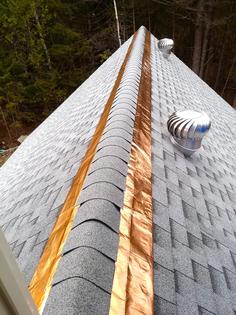Ask the Builder: The fountain of youth for your asphalt shingles
I live in central New Hampshire, and my house was built in 2001. I didn’t build it. The plan was for me to live in this home for just two years while I built our dream home on a tract of land we own just six miles west of here. All of this was put into motion in May 2008 when the real estate bubble was as big as a bulbous hot-air balloon.
I moved from Cincinnati to New Hampshire in July 2008 with my oldest daughter. My wife and youngest daughter remained in Cincinnati until August 2010. By then I was supposed to have the new home ready for occupancy. But then things went south in September 2008. A lot of us took a huge financial hit as the real estate market collapsed. The new home never happened because we lost too much equity in the Cincinnati home.
I share this with you because when I inspected my New Hampshire home, I just gave the roof a cursory look. The original homeowner had the shingle brand's brochure and it clearly showed the roof had a 30-year warranty. At that point, there were at least 23 years worth of life left in them. I didn’t care, as I only planned to be here for 24 months.
Several years after the economic collapse, I knew this house was going to be my home for quite some time. One day, while sitting out on the deck, I noticed the shingles were starting to develop a slight curl. I also noticed more and more green ceramic granules on the ground and deck after each rain. My roof was going to go bad long before it should. Does this sound familiar? Do you see premature wear on your asphalt shingles?
Soon the wear started to accelerate. I could see bare patches of asphalt mat where the protective granules no longer existed. The purpose of the granules is to stop the sun’s ultraviolet (UV) light from hitting the asphalt. Some UV light rays contain active photons. These are like invisible cruise missiles. When they strike an object, they blast apart the molecules. This is why fabrics become weak and tear easily if left in the sun. It’s why the color fades on many things left out in the sun.
UV light was destroying my shingles. Several years ago, it got so bad that I had to replace my roof. Before it happened, I noticed advertisements in our local weekly newspaper. A roofer was advertising his services to help homeowners file warranty claims for defective shingles. This caught my attention. The problem must be widespread here in New Hampshire. It was way worse. It was a nationwide problem.
I bit the bullet and started to replace my roof. There was no way I was going to install asphalt shingles again. I decided to use a virgin vinyl product that looked exactly like real slate. It’s a stunning product. Two companies in the USA produce this roofing material: DaVinci and Brava.
One particular blazing hot day I was working and became agitated. I was furious that I was suffering from the heat and financial loss when the shingles should not have been going bad. I did get a very small settlement from my shingle manufacturer, but it didn’t even cover 3% of the cost to install the new roof.
I decided to find out what was causing the problem. I wanted to know why my shingles, and those of hundreds of thousands of other homeowners, were failing. With the help of a deep-throat source within the asphalt shingle industry who was ethically challenged, I discovered the root cause. Too much air was being blown into the asphalt in the manufacturing process. The air caused the shingles to think they were twenty years old before they were even installed!
I continued my research and then wrote a small book about all that was happening. It’s called "Roofing Ripoff: Why Your Asphalt Shingles are Falling Apart and What You Can Do About It." You can purchase a PDF version at AsktheBuilder.com or get a paperback version on Amazon.com.
As I was finishing the book, by chance one day, I discovered how to extend the life of asphalt shingles by 40 or more years. Exiting a restaurant, I looked across the street to the empty Tilton, New Hampshire, post office. I saw a strip of asphalt shingles under a cupola that had a copper roof. The shingles under the cupola looked brand new. The rest of the roof was the worst I’d ever seen. All the shingles were curled and missing most of their granules.
I knew the copper washing off the cupola roof was protecting the shingles but didn’t know why. I reached out to the tens of thousands of subscribers on my free newsletter trying to locate a physical chemist. Three subscribers got back to me. Once I shared what I saw, they all agreed on what was happening.
The shingles degrade because the UV rays break apart the asphalt molecules. The broken molecules grab oxygen from the air and begin to cross-link with one another. When too many cross-link, the asphalt becomes brittle. This is why the curl you see can’t relax and lay flat. The brittle asphalt can’t hold onto the ceramic granules.
The copper prevents cross-linking. The UV rays blast copper ions off the copper and these wash onto the shingles. The copper bonds to the asphalt and prevents cross-linking. When this happens, your roof thinks the rain is the fountain of youth. Put copper strips on top of your roof to slow the aging process to a crawl. Be sure to blind-nail the strips.
Subscribe to Tim’s FREE newsletter at AsktheBuilder.com. Tim offers phone coaching calls if you get stuck during a DIY job. Go here: go.askthebuilder.com/coaching
©2024 Tim Carter. Distributed by Tribune Content Agency, LLC.







